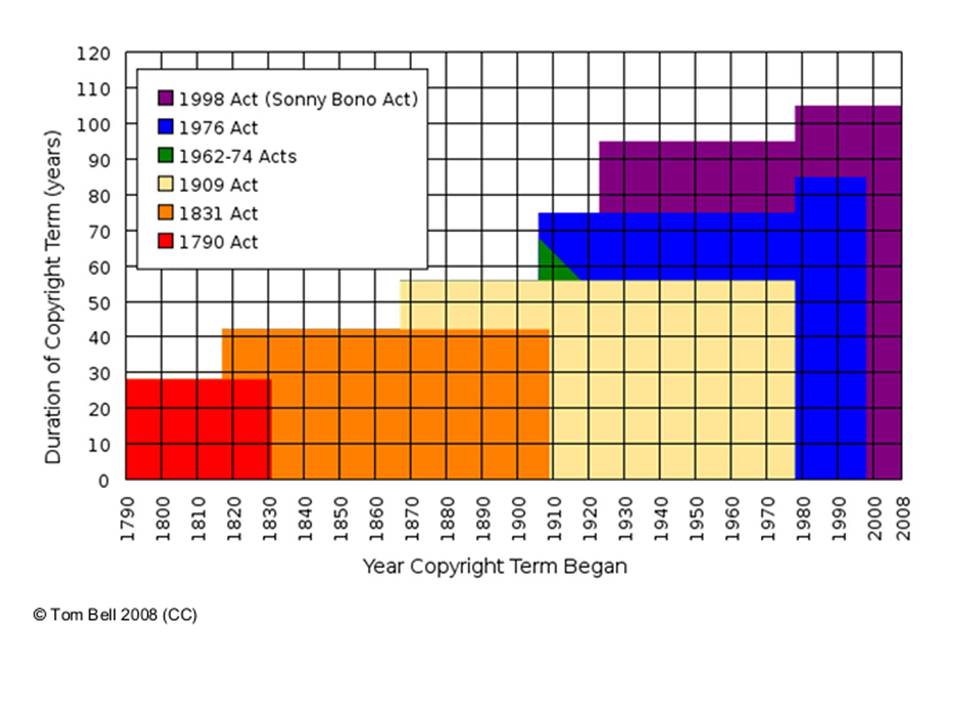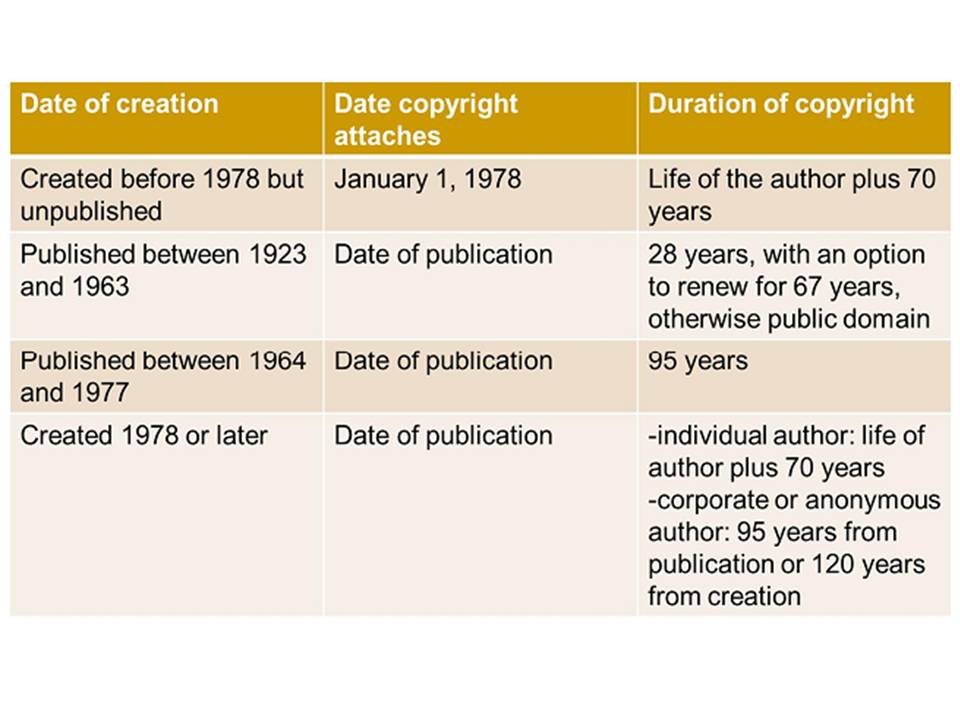Version [31384]
Dies ist eine alte Version von IntUrhRLimitationsTemporal erstellt von Jorina Lossau am 2013-06-17 21:50:05.
Internationaler Gewerblicher Rechtsschutz und Urheberrecht II
5.1 - Temporal Limitations
| Temporal limitations mean the duration of a copyright. Originally the timely scope of copyright was limited to 14 years after publication and registration of a work, later with the possible renewal of the registration for another 14 years. The Copyright Act 1831 extended the duration to 28 years with a possible renewal of 14 years, the Copyright Act 1909 extended the renewal period to also 28 years. With the Copyright Act 1976 the entire copyright duration system was changed as publication or registration were no longer requirements for copyright protection. The duration for all works created after January 1st 1978 was subsequent 50 years after death of the author. Earlier published works had a copyright term of 28 years with a possible renewal of 67 years; this renewal was automatically made by the Copyright Renewal Act 1992. |

| The Sonny Bono Copyright Term Extension Act 1998tried to save the copyright protection especially for all popular contents (e.g. Mickey Mouse, music of George Gershwin) that are mainly created since 1923 for a longer period. (Note: Other initiatives demanded a duration of “forever minus a day” as Constitution forbids a copyright protection forever). |
Committee Reports, House Reports 105-452 (1998)
(…) Upon the expiration of the copyright term, the work falls into the public domain. This means that anyone may perform the work, display the work, make copies of the work, distribute copies of the work, and create derivative works based on the work without first having to get authorization from the copyright holder. Essentially, the copyright holder no longer has the exclusive ability to exploit the work to their financial gain and no longer `owns' the work. The United States has international obligations to protect copyrights as well. The Berne Convention, originally drafted in 1886, is the international treaty which mandates basic copyright protection rules for its member countries. Currently there are over 100 countries that are members of the convention. The United States became a member in 1989. Under the Berne Convention, member countries must protect copyright for a term of life of the author plus fifty years. Under `the rule of the shorter term', member states need only protect the work of foreign authors to the same extent that they would be protected in their country of origin.
|
The current system of copyright duration is according to 17 U.S.C. §§ 302-304:

| Although the continuous extension of copyright protection term is widely attacked by academics and consumer organizations, the Supreme Court accepted the existing copyright term system (Eldred v. Ashcroft, 537 U.S. 186 (2003). |
13.9.2012 Chris Sprigman, The Mouse That Ate the Public Domain: Disney, The Copyright Term Extension Act and Eldred v. Ashcroft
(…) Back in 1998, representatives of the Walt Disney Company came to Washington looking for help. Disney's copyright on Mickey Mouse, who made his screen debut in the 1928 cartoon short "Steamboat Willie," was due to expire in 2003, and Disney's rights to Pluto, Goofy and Donald Duck were to expire a few years later. Rather than allow Mickey and friends to enter the public domain, Disney and itsfriends - a group of Hollywood studios, music labels, and PACs representing content owners - told Congress that they wanted an extension bill passed. Prompted perhaps by the Disney group's lavish donations of campaign cash - more than $6.3 million in 1997-98, (…) - Congress passed and President Clinton signed the Sonny Bono Copyright Term Extension Act (Note: CTEA). (…) Most likely to succeed is Eldred's argument that the CTEA exceeds Congress's power under the Constitution's Copyright Clause (Article I, Section 8), which provides that The Copyright Clause does two things. First, it empowers Congress to "promote the Progress of Science and useful Arts." Second, the text of the Copyright Clause limits the means that Congress may adopt in exercising the enumerated power. Congress is limited to granting rights to authors for "limited Times" - there can be no perpetual ownership of intellectual property. (…) Seen in this light, the CTEA cannot survive. Because already existing works cannot be created anew, extension of subsisting copyrights does not "promote progress." Congress is not empowered merely to provide copyright holders with an additional boon - that is not "progress", but corporate welfare. (…)
Artists Depend On A Rich Public Domain
If we know little about the utility of longer copyright terms, there is abundant evidence regarding the vital importance to the progress of our culture of a robust stock of public domain works. Most artists, if pressed, will admit that the true mother of invention in the arts is not necessity, but theft. And this is true even for our greatest artists. Shakespeare's Romeo and Juliet (1591) was taken from Arthur Brooke's poem Romeus and Juliet (1562), and most of Shakespeare's historical plays would have infringed Holingshead's Chronicles of England(1573). For the third movement of the overture to Theodora, Handel drew on a harpsichord piece by Gottlieb Muffat (1690-1770). (…) Cultural giants borrow, and so do corporate giants. Ironically, many of Disney's animated films are based on Nineteenth Century public domain works, including Snow White and the Seven Dwarfs, Cinderella, Pinocchio, The Hunchback of Notre Dame, Alice in Wonderland, and The Jungle Book(released exactly one year after Kipling's copyrights expired). Borrowing is ubiquitous, inevitable, and, most importantly, good. Contrary to the romantic notion that true genius inheres in creating something completely new, genius is often better described as opening up new meanings on well-trodden themes. Leonard Bernstein's reworking in West Side Story of Romeo and Julietis a good example. |
| Works that are no longer protected are public domain. Currently all works created before 1923 are in the public domain. For other works the situation can be difficult. |
Diese Seite wurde noch nicht kommentiert.





